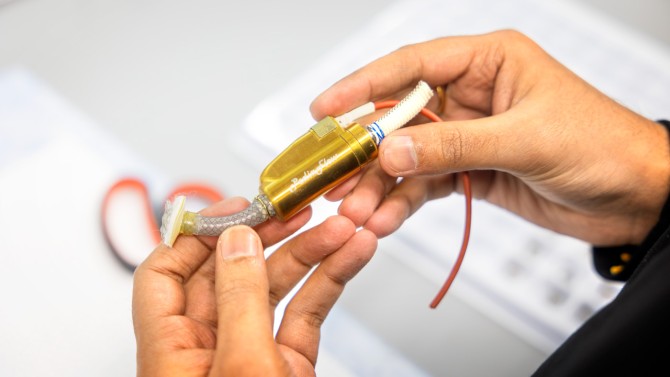On a lab bench in the basement of Weill Hall, a tiny device silently pumps fluid through a series of tubes and vessels that mimic the human heart. It has the potential to save the lives of tens of thousands of babies with heart defects.
But after receiving a stop-work order from the federal government, the project's future is uncertain.
On March 30, the U.S. Department of Defense accepted a proposal to prepare the device for in-human clinical trial, ramping up manufacturing and obtaining regulatory approvals. A week later, the researchers got word that the funding - $6.7 million over the course of four years - wasn't coming.
A prototype of the PediaFlow heart-assist device for children.
"Interruption of that funding has really brought us to a screeching halt," said James Antaki, the Susan K. McAdam Professor of Heart Assist Technology at the Meinig School of Biomedical Engineering, in Cornell Engineering. "If the interruption lasts very long, it would be irreversible. We'll have to start laying off people, and I don't think we'd be able to recover."
Antaki began to work on the device now known as the PediaFlow in 2002, and he and his team recently wrapped up a previous federal grant started in 2019 to improve the device. About the size of an AA battery, it is designed to boost the flow of blood in children with heart defects.
"The PediaFlow is intended for children with congenital and acquired heart disease," Antaki said. "That means babies that are born with a hole in the heart or with a missing ventricle that need serious surgery to survive. Sometimes the child can't survive to surgery and they need some kind of crutch to get them over that difficult period."
Heart-assist pumps can also provide support until a donor heart becomes available for transplant.
Existing heart-pump technology requires children to be tethered to a refrigerator-sized compressor in a hospital. The PediaFlow would enable children to go home with their families.
Portable heart-assist devices do exist for adults, but they can't simply be scaled down for use in children, Antaki said.
"Babies aren't small adults," Antaki said. "They have a different anatomy, different physiology. Their blood is more delicate. Their tissues are more delicate."
Approximately 40,000 children born every year have some type of heart condition, Antaki said, but that isn't a large enough number to incentivize medical device companies to invest in the development and testing required to bring the PediaFlow to market.
"For that reason," Antaki said, "our only option is federal funding, and it also explains why devices like this are not being developed in other countries because they don't have the benefit of federal funding. We've been very fortunate to make it as far as we have because of federal funding."
Today "the project is on life support," Antaki said. The PediaFlow on the bench has been running for 30 days as they test its performance and durability, but without a restoration of funding the device may have to go back on the shelf.
"I've been working on it for over 30 years," Antaki said. "It has been a holy grail, a labor of love."







